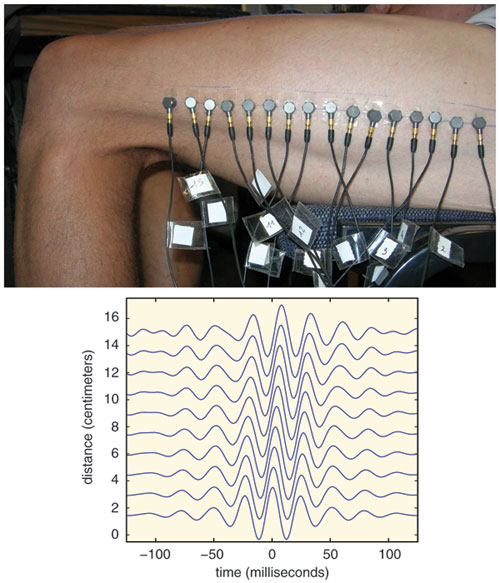Sounding Out Muscle Health
By Fenella Saunders
The noise of contraction could help to diagnose disease
The noise of contraction could help to diagnose disease

DOI: 10.1511/2008.69.25
The simple act of bending a knee requires the coordination of more strings than a symphony orchestra. Each muscle cell is made up of many tiny filaments of proteins. When a muscle contracts, these fibers change shape and slide past one another, creating vibrations.
"It's like plucking a string, and the sound can tell you about the elastic properties of the muscle," says Karim Sabra, a mechanical engineer at the Georgia Institute of Technology. Sabra is measuring the noise from healthy muscles in the hope that this baseline information could be used in the future to help diagnose muscular diseases or injuries.

Images courtesy of Karim Sabra.
It's possible to hear muscular noise for yourself. If you place your thumbs gently over your ear openings so they completely cover your ear canals, then with your elbows raised tighten your hands into fists, you will hear a sound that resembles distant rolling thunder, which becomes louder the tighter the fist is made. This phenomenon was first described in the late 1600s. Leg muscle sounds were first observed in the 1800s.
During contraction, the overall volume of a muscle fiber stays the same. So in order to shorten, the fiber has to expand in width. The muscles become harder during this process. "Sound travels faster through stiffer muscles, and slower through softer ones," explains Sabra.
For about a century, scientists have measured the sound that travels through muscles from an outside source, when they are induced to contract by electrical stimulation. Recently doctors have also used ultrasound and magnetic resonance as sound sources. "But muscles signal by themselves when they contract and generate these vibrations," Sabra says. Such passive, random noise is used to make measurements in other fields, such as seismology, mechanical engineering and oceanography.
While Sabra was working at the Scripps Institution of Oceanography, he got the idea to apply the same kind of passive noise detection to muscles. He and his Scripps colleagues placed 16 sensors, each about a half an inch apart, on the skin along the side of the thigh of a healthy male volunteer. They attached increasing amounts of weight to the man's ankle, gradually ramping up the contraction in the thigh muscle.
The team measured the vibration from the muscle contraction at each sensor. They used only the high-frequency part of the noise, as this was the clearest part of the signal. The noise propagates throughout the leg, but by correlating several seconds of signal from each sensor, they were able to extract the portion of the waveform that traveled down the leg, from sensor to sensor. The time lapse for the signal to reach each sensor allowed them to construct the path of the signal and the speed of the wave. Because sound speed is related to muscle stiffness, they were able then to profile the muscle's characteristics as it contracted under different loads.
Sabra's current research goal is to provide a baseline for healthy muscle. The frequency of the vibrations depends on the size of the muscle, so a large library is needed to characterize the body. He is also studying different sensor patterns to better understand how the vibration propagates, and he is looking at other muscles in the biceps and calf.
One advantage of this passive measurement is that it does not require any radiation exposure for the patient, as is the case with procedures such as computed axial tomography. And the sensors Sabra uses are much less expensive than, say, an MRI machine. In addition, Sabra points out that it's possible for measurements made from an external source, applied to just one area, to give somewhat arbitrary readings based on their location. Natural sounds are distributed evenly, so they may provide for more comprehensive analysis.
If the technique works, it could be used to monitor muscle degeneration in Parkinson's disease patients, for instance, or perhaps even provide an aid for early diagnosis. Sabra expects that the intensity of the noise spectra will change in Parkinson's sufferers.
In orthopedics, the method may be helpful in tracking muscles that are recovering from injury, for instance to ensure that physical therapy is having the desired effect.
"The type of fiber is also linked to the noise," says Sabra. "There are slow fibers and fast fibers, so this is a noninvasive way of tracking fiber composition." Such information could be useful to athletes training for specific sports, such as cycling or marathon running.
Click "American Scientist" to access home page
American Scientist Comments and Discussion
To discuss our articles or comment on them, please share them and tag American Scientist on social media platforms. Here are links to our profiles on Twitter, Facebook, and LinkedIn.
If we re-share your post, we will moderate comments/discussion following our comments policy.